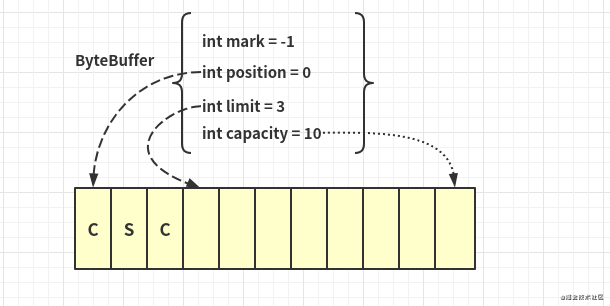前言
数据序列化存储,或者数据通过网络传输时,会遇到不可避免将数据转成字节数组的场景。字节数组的读写不会太难,但又有点繁琐,为了避免重复造轮子,jdk推出了ByteBuffer来帮助我们操作字节数组;而netty是一款当前流行的java网络IO框架,它内部定义了一个ByteBuf来管理字节数组,和ByteBuffer大同小异
- ByteBuffer
- 零拷贝之MappedByteBuffer
- DirectByteBuffer堆外内存回收机制
- netty之ByteBuf
关注公众号,一起交流,微信搜一搜: 潜行前行
Buffer结构
public abstract class Buffer {
//关系: mark <= position <= limit <= capacity
private int mark = -1;
private int position = 0;
private int limit;
private int capacity;
long address; // Used only by direct buffers,直接内存的地址- mark:调用mark()方法的话,mark值将存储当前position的值,等下次调用reset()方法时,会设定position的值为之前的标记值
- position:是下一个要被读写的byte元素的下标索引
- limit:是缓冲区中第一个不能读写的元素的数组下标索引,也可以认为是缓冲区中实际元素的数量
- capacity:是缓冲区能够容纳元素的最大数量,这个值在缓冲区创建时被设定,而且不能够改变
Buffer.API
Buffer(int mark, int pos, int lim, int cap)
//Buffer创建时设置的最大数组容量值
public final int capacity()
//当前指针的位置
public final int position()
//限制可读写大小
public final Buffer limit(int newLimit)
//标记当前position的位置
public final Buffer mark()
//配合mark使用,position成之前mark()标志的位置。先前没调用mark则报错
public final Buffer reset()
//写->读模式翻转,单向的
//position变成了初值位置0,而limit变成了写模式下position位置
public final Buffer flip()
//重置position指针位置为0,mark为-1;相对flip方法是limit不变
public final Buffer rewind() //复位
//和rewind一样,多出一步是limit会被设置成capacity
public final Buffer clear()
//返回剩余未读字节数
public final int remaining()ByteBuffer结构
public abstract class ByteBuffer extends Buffer
implements Comparable{
final byte[] hb; //仅限堆内内存使用
final int offset;
boolean isReadOnly; ByteBuffer.API
//申请堆外内存
public static ByteBuffer allocateDirect(int capacity)
//申请堆内内存
public static ByteBuffer allocate(int capacity)
//原始字节包装成ByteBuffer
public static ByteBuffer wrap(byte[] array, int offset, int length)
//原始字节包装成ByteBuffer
public static ByteBuffer wrap(byte[] array)
//创建共享此缓冲区内容的新字节缓冲区
public abstract ByteBuffer duplicate()
//分片,创建一个新的字节缓冲区
//新ByteBuffer的开始位置是此缓冲区的当前位置position
public abstract ByteBuffer slice()
//获取字节内容
public abstract byte get()
//从ByteBuffer偏移offset的位置,获取length长的字节数组,然后返回当前ByteBuffer对象
public ByteBuffer get(byte[] dst, int offset, int length)
//设置byte内存
public abstract ByteBuffer put(byte b);
//以offset为起始位置设置length长src的内容,并返回当前ByteBuffer对象
public ByteBuffer put(byte[] src, int offset, int length长)
//将没有读完的数据移到到缓冲区的初始位置,position设置为最后一没读字节数据的下个索引,limit重置为为capacity
//读->写模式,相当于flip的反向操作
public abstract ByteBuffer compact()
//是否是直接内存
public abstract boolean isDirect()- ByteBuffer bf = ByteBuffer.allocate(10);`,创建大小为10的ByteBuffer对象
- 写入数据
ByteBuffer buf ByteBuffer.allocate(10);
buf.put("csc".getBytes());- 调用flip转换缓冲区为读模式;
buf.flip();
- 读取缓冲区中到内容:get();
System.out.println((char) buf.get());
零拷贝之MappedByteBuffer
- 共享内存映射文件,对应的ByteBuffer子操作类,MappedByteBuffer是基于mmap实现的。关于零拷贝的mmap的底层原理可以看看:框架篇:小白也能秒懂的Linux零拷贝原理。MappedByteBuffer需要FileChannel调用本地map函数映射。C++代码可以查阅下FileChannelImpl.c-Java_sun_nio_ch_FileChannelImpl_map0方法
- 使用MappedByteBuffer和文件映射,其读写可以减少内存拷贝次数
FileChannel readChannel = FileChannel.open(Paths.get("./cscw.txt"), StandardOpenOption.READ);
MappedByteBuffer data = readChannel.map(FileChannel.MapMode.READ_ONLY, 0, 1024 * 1024 * 40);DirectByteBuffer堆外内存回收机制Cleaner
- 下面我们看看直接内存的回收机制(java8);DirectByteBuffer内部存在一个Cleaner对象,并且委托内部类Deallocator对象进行内存回收
class DirectByteBuffer extends MappedByteBuffer implements DirectBuffer
{
//构造函数
DirectByteBuffer(int cap) {
.... //内存分配
cleaner = Cleaner.create(this, new Deallocator(base, size, cap));
...
}
private static class Deallocator implements Runnable{
...
public void run() {
if (address == 0) {
// Paranoia
return;
}
unsafe.freeMemory(address); //回收内存
address = 0;
Bits.unreserveMemory(size, capacity);
}
}- 细看下Cleaner,继承于PhantomReference,并且在
public void clean()方法会调用Deallocator进行清除操作
public class Cleaner extends PhantomReference- 在Reference内部存在一个守护线程,循环获取Reference,并判断是否Cleaner对象,如果是则调用其clean方法
public abstract class Reference
static {
ThreadGroup tg = Thread.currentThread().getThreadGroup();
for (ThreadGroup tgn = tg; tgn != null; g = tgn, tgn = tg.getParent());
Thread handler = new ReferenceHandler(tg, "Reference Handler");
...
handler.setDaemon(true);
handler.start();
...
}
...
//内部类调用 tryHandlePending
private static class ReferenceHandler extends Thread {
public void run() {
while (true) {
tryHandlePending(true);
}
}
...
static boolean tryHandlePending(boolean waitForNotify) {
Cleaner c;
.... //从链表获取对象被回收的引用
// 判断Reference是否Cleaner,如果是则调用其clean方法
if (c != null) {
c.clean(); //调用Cleaner的clean方法
return true;
}
ReferenceQueue q = r.queue;
if (q != ReferenceQueue.NULL) q.enqueue(r);
return true; netty之ByteBuf
- ByteBuf原理
- Bytebuf通过两个位置指针来协助缓冲区的读写操作,分别是readIndex和writerIndex
* +-------------------+------------------+------------------+
* | discardable bytes | readable bytes | writable bytes |
* | | (CONTENT) | |
* +-------------------+------------------+------------------+
* | | | |
* 0 <= readerIndex <= writerIndex <= capacity- ByteBuf.API
//获取ByteBuf分配器
public abstract ByteBufAllocator alloc()
//丢弃可读字节
public abstract ByteBuf discardReadBytes()
//返回读指针
public abstract int readerIndex()
//设置读指针
public abstract ByteBuf readerIndex(int readerIndex);
//标志当前读指针位置,配合resetReaderIndex使用
public abstract ByteBuf markReaderIndex()
public abstract ByteBuf resetReaderIndex()
//返回可读字节数
public abstract int readableBytes()
//返回写指针
public abstract int writerIndex()
//设置写指针
public abstract ByteBuf writerIndex(int writerIndex);
//标志当前写指针位置,配合resetWriterIndex使用
public abstract ByteBuf markWriterIndex()
public abstract ByteBuf resetWriterIndex()
//返回可写字节数
public abstract int writableBytes()
public abstract ByteBuf clear();
//设置读写指针
public abstract ByteBuf setIndex(int readerIndex, int writerIndex)
//指针跳过length
public abstract ByteBuf skipBytes(int length)
//以当前位置切分ByteBuf todo
public abstract ByteBuf slice();
//切割起始位置为index,长度为length的ByteBuf todo
public abstract ByteBuf slice(int index, int length);
//Returns a copy of this buffer's readable bytes. //复制ByteBuf todo
public abstract ByteBuf copy()
//是否可读
public abstract boolean isReadable()
//是否可写
public abstract boolean isWritable()
//字节编码顺序
public abstract ByteOrder order()
//是否在直接内存申请的ByteBuf
public abstract boolean isDirect()
//转为jdk.NIO的ByteBuffer类
public abstract ByteBuffer nioBuffer()- 使用示例
public static void main(String[] args) {
//分配大小为10的内存
ByteBuf buf = Unpooled.buffer(10);
//写入
buf.writeBytes("csc".getBytes());
//读取
byte[] b = new byte[3];
buf.readBytes(b);
System.out.println(new String(b));
System.out.println(buf.writerIndex());
System.out.println(buf.readerIndex());
}
----result----
csc
3
3- ByteBuf初始化时,readIndex和writerIndex等于0,调用
writeXXX()方法写入数据,writerIndex会增加(setXXX方法无作用);调用readXXX()方法读取数据,则会使readIndex增加(getXXX方法无作用),但不会超过writerIndex - 在读取数据之后,0-readIndex之间的byte数据被视为discard,调用discardReadBytes(),释放这部分空间,作用类似于ByteBuffer的compact方法




